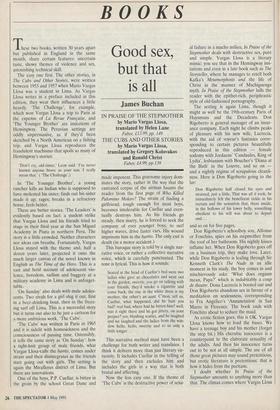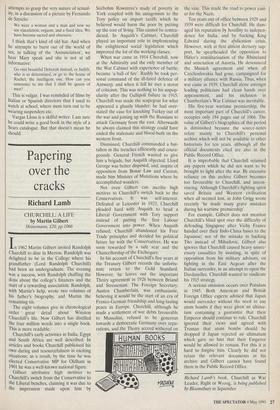BOOKS
Good sex, but that is all
James Buchan
These two books, written 30 years apart but published in England in the same month, share certain features: uncertain taste, showy themes of violence and sex, astonishing technical skill.
The easy one first. The other stories, in The Cubs and Other Stories, were written between 1953 and 1957 when Mario Vargas Llosa was a student in Lima. As Vargas Llosa writes in a preface included in this edition, they wear their influences a little heavily. 'The Challenge', for example, which won Vargas Llosa a trip to Paris at the expense of La Revue Francaise, and 'The Younger Brother' are imitations of Hemingway. The Peruvian settings are oddly unpersuasive, as if they'd been sketched by a North American on a fishing trip, and Vargas Llosa reproduces the fraudulent machismo that spoils so many of Hemingway's stories:
`Don't cry, old-timer,' Leon said. 'I've never known anyone brave as your son. I really mean that.' ( 'The Challenge'.)
In 'The Younger Brother', a young rancher kills an Indian who is supposed to have molested his sister; finds out his sister made it up; rages; breaks in a refractory horse; feels better.
There are better stories. 'The Leaders' is evidently based on fact: a student strike that Vargas Llosa and his friends tried to stage in their final year at the San Miguel Academy in Piura in northern Peru. The story is a little crowded. Neither characters nor ideas can breathe. Fortunately, Vargas Llosa stayed with the theme and, half a dozen years later, projected it onto the much larger canvas of the novel known in English as The Time of the Hero. This is a vast and lurid account of adolescent vio- lence, boredom, sadism and buggery at a military academy in Lima and is unforget- table.
'On Sunday' also deals with male adoles- cents. Two rivals for a girl slug it out, first in a beer-drinking bout, then in the freez- ing surf off Lima. This is a successful story but it turns out also to be just a cartoon for a more ambitious work, 'The Cubs'.
'The Cubs' was written in Paris in 1965 and it is sidelit with homesickness and the consciousness of passing time. Ostensibly, it tells the same story as 'On Sunday': how a tight-knit group of male friends, what Vargas Llosa •calls the barrio, comes under strain and then disintegrates as the friends start going out with girls. The setting is again the Miraflores district of Lima. But there are innovations.
One of the boys, P.P. Cuellar, is bitten in the groin by the school Great Dane and
made impotent. This gruesome injury dom- inates the story, rather in the way that the castrated corpse of the airman haunts the reader from the first page of Who Killed Palomino Molero? The strain of finding a girlfriend, tough enough for most boys, becomes intolerable for Cuellar and even- tually destroys him. As his friends go steady, then marry, he is forced to seek the company of ever younger boys, to surf higher waves, drive faster cars. His wound imprisons him in the barrio. The only exit is death (in a motor accident.)
This baroque story is told by a single nar- rative voice, or rather a collective narrative voice, which is carefully punctuated. The tone is lyrical. This is how it sounds:
Seated at the head of Cuellar's bed were two ladies who gave us chocolates and went out in the garden, sweetie, you go on talking with your friends, they'd smoke a cigarette and come back, the one in the white dress is my mother, the other's an aunt. C'mon, tell us, Cuellar, what happened, did he hurt you bad? real bad, where had he bitten him? well, was it right there and he got jittery, on your peepee? yes, blushing scarlet, and he laughed and we laughed and the ladies from the win- dow hello, hello, sweetie and to us only a little longer. . .
This narrative method must have been a challenge for both writer and translator. I think it delivers more than just literary vir- tuosity. It includes Cuellar in the telling of the story and then excludes him and includes the girls in a way that is both brutal and affecting.
Now the less easy one. If the theme of 'The Cubs' is the destructive power of sexu- al failure in a macho milieu, In Praise of the Stepmother deals with destructive sex, pure and simple. Vargas Llosa is a literary mimic: you see that in the Hemingway imi- tations and even in a late book such as The Storyteller, where he manages to retell both Kaflca's Metamorphosis and the life of Christ in the manner of Machiguenga myth. In Praise of the Stepmother lulls the reader with the epithet-rich, periphrastic style of old-fashioned pornography.
The setting is again Lima, though it might as well be the 19th-century Paris of Huysmans and the Decadents. Don Rigoberto is general manager of an insur- ance company. Each night he climbs peaks of pleasure with his new wife, Lucrecia, with the aid of voyeur's fantasies corre- sponding to certain pictures beautifully reproduced in this edition — female sodomy with Jordaens"Candaules, King of Lydia', lesbianism with Boucher's 'Diana at the Bath' in the Louvre, and so on — and a nightly regime of scrupulous cleanli- ness. Here is Don Rigoberto going to the lay:
Don Rigoberto half closed his eyes and strained, just a little. That was all it took; he immediately felt the beneficent tickle in his rectum and the sensation that, there inside, in the hollows of his lower belly, something obedient to his will was about to depart and...
and so on for five pages.
Don Rigoberto's schoolboy son, Alfonso or Fonchito, spies on his stepmother from the roof of her bathroom. His nightly kisses inflame her. When Don Rigoberto goes off on a business trip, they make love. Later, while Don Rigoberto is leafing through Sir Kenneth Clark's The Nude in an idle moment in his study, the boy comes in and mischievously asks: 'What does orgasm mean, Papa?' which is indubitably a coup de theatre. Dona Lucrecia is booted out and Don Rigoberto abandons sex in favour of a meditation on sexlessness, corresponding to Fra Angelico's 'Annunciation' in San Marco in Florence. The book ends with Fonchito about to seduce the maid.
As erotic fiction goes, this is OK. Vargas Llosa knows how to load the bases. We have a teenage boy and his mother (forget the step bit.) His cherubic innocence is a counterpoint to the elaborate sexuality of the adults. And then his innocence turns out to be not at all simple. The use of all those great pictures may sound pretentious, but erotic literature is pretentious: that is how it hides from the puritans.
I doubt whether In Praise of the Stepmother amounts to anything more than that. The climax comes where Vargas Llosa
attempts to grasp the very nature of sexual- ity, in a discussion of a picture by Fernando de Szyszlo:
We were a woman and a man and now we are ejaculation, orgasm, and a fixed idea. We have become sacred and obsessive.
I think that's kind of old hat. And when he attempts to burst out of the world of sex, in talking of the 'Annunciation', we hear Mary speak and she is not at all informative:
Go visit beautiful Deborah instead, or Judith, who is so determined, or go to the house of Rachel, the intelligent one. How can you announce to me that I shall be queen of men?
This is vulgar. I was reminded of films by Italian or Spanish directors that I used to watch at school, where nuns turn out to be wearing suspenders etc.
Vargas Llosa is a skilful writer. I am sure he could write a good book in the style of a Sears catalogue. But that doesn't mean he Should.



















































 Previous page
Previous page